Bernhard Lederer Central Impulse Chronometer*: A Superlative Watch But Is It Really A Chronometer?
The Koenigsegg Agera One:1 was built for two main reasons:
- To be the first production street-legal car to have a 1:1 power-to-weight ratio thanks to its 1,360 horsepower and 1,360 kg curb weight.
- To shatter the lap record for a production car at the Nürburgring.
It successfully achieved the first, but the second remains unachieved after six years and it is likely to remain so for the car is now out of production and Koenigsegg is moving on to another model. What’s more, the track-focused Koenigsegg models have had some bad luck when trying to set major lap records and some unlucky crashes by some of the best drivers in the world.
For a car designed to be an ultimate track monster, having a litany of crashes on your record doesn’t leave a good taste in your mouth when you are aiming for the podium. The One:1 set a lap record at Spa in Belgium but was also hampered in that attempt by noise restrictions that limited the ability to drive at maximum speed. Even with that record, Spa isn’t the same as the Nürburgring, which is considered the Mount Everest of race tracks.
There might be faster tracks, more technical tracks, or even more risky tracks, but nothing can compare to the extra-long, technical, and often unpredictable Nürburgring. And it holds a certain prestige when it comes to setting a record. If your car sets a record at the Nürburgring, you go down in history as one of the best cars ever made.
And that is why the Koenigsegg Agera One:1 has a major asterisk next to its name: it remains somewhat unproven. Even though it was the fastest production car in the world for a while, it still is unable to claim the title as the fastest track car ever made. And since that was a goal of its creation – to be listed as the fastest track car – it can’t help but be a bit disappointing in its incredible awesomeness.
It is undoubtedly one of the coolest, fastest, and wildest cars ever made, and to be able to simply see one is a great honor for most car fanatics. But when you design a machine to do a very specific task and it has been left untested or hasn’t fully succeeded, then that machine cannot yet be fully appreciated for what it is.
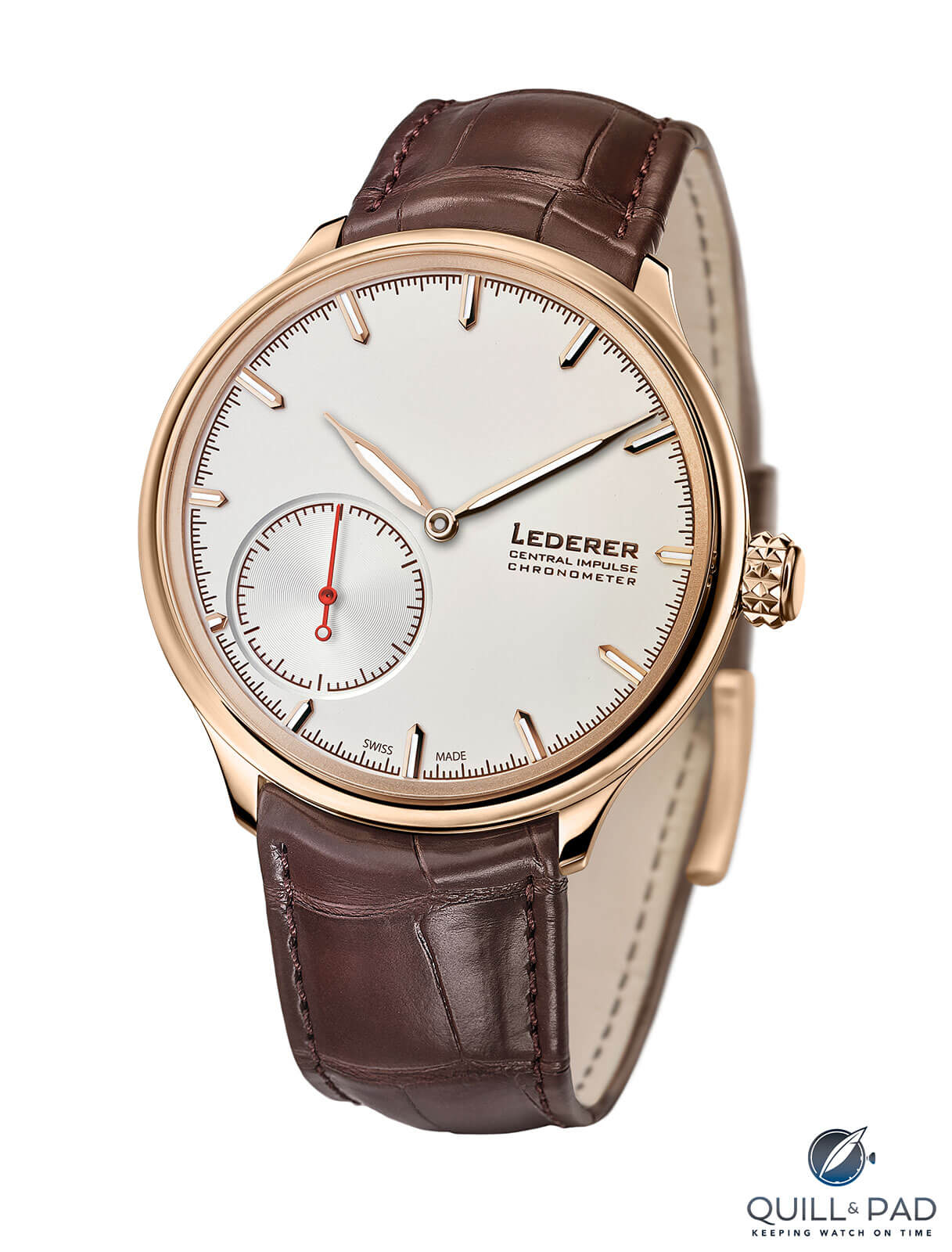
Bernhard Lederer Central Impulse Chronometer in pink gold
That brings me to the topic of today’s discussion, the horological smorgasbord that is the Bernhard Lederer Central Impulse Chronometer.
Bernhard Lederer Central Impulse Chronometer
The Bernhard Lederer Central Impulse Chronometer may just be one of the most astounding timepieces to be released in 2020, and when I first saw it on social media I actually gasped out loud. The more I looked at it the more I fell in love with the style, the engineering, and the concept behind the movement.
But as I dove deeper, I discovered a glaring omission that puts the entire thing into question. But before I touch on what is missing for me (and why I started this post out with the Koenigsegg Agera One:1) let’s talk about who Bernhard Lederer is, what the Central Impulse Chronometer is, and why it looks so incredible at first glance.
Who is Bernhard Lederer?
Bernard Lederer is an independent watchmaker known for some rather unique conceptual watches. As blu (Bernhard Lederer Universe), in 2007 he created the Majesty Tourbillon MT3. That was an open-dial watch based on a seemingly simple mechanism that was in actuality a cage-less triple tourbillon with seconds displayed via a 60-second tourbillon, which then further rotated once an hour, indicating minutes, with the entire dial mechanism making a full revolution once every 12 hours. It was anything but traditional and very cool.
In 2011 Lederer released another concept watch as a homage to Yuri Gagarin’s historic space flight. The Gagarin Tourbillon featured a large tourbillon supported by a massive arcing bridge that (unsurprisingly) orbited the dial every 108 minutes to commemorate the time that Gagarin took to orbit the earth during his flight. It also featured a bezel-mounted loupe that could rotate around the entire watch to get a good look at the tourbillon or be flipped up for an unobstructed view of the engraved dial bearing a depiction of the earth.
While the style was definitely a classic aesthetic, the implementation was out of this world (see what I did there?). That kind of gives you an idea into how Bernhard Lederer thinks about conceptual horology: he likes to take some very traditional concepts and approach them from an angle most might not think to. Having been a member of the AHCI since its founding year in 1985, and progressing on a career path from apprenticeship to watch repairer and restorer without traditional schooling, one might think that he would stay on the conceptual side of things.
But in 2016 Lederer introduced a movement that was extremely non-magnetic, able to withstand 100,000 gauss, making it 100 times less magnetically reactive than the Rolex Milgauss. This is a stark departure from the conceptual, but also highlights Lederer’s focus on solving problems and creating functionally better watches.
After all that, it should come as no surprise that in 2014 he also began looking into escapements, and improving the regulator became his main focus.
Bernard Lederer Central Impulse Chronometer with natural escapement
With that we return to the Central Impulse Chronometer, which is built entirely around the concept of the natural escapement invented by Abraham-Louis Breguet and later improved by the legendary George Daniels.
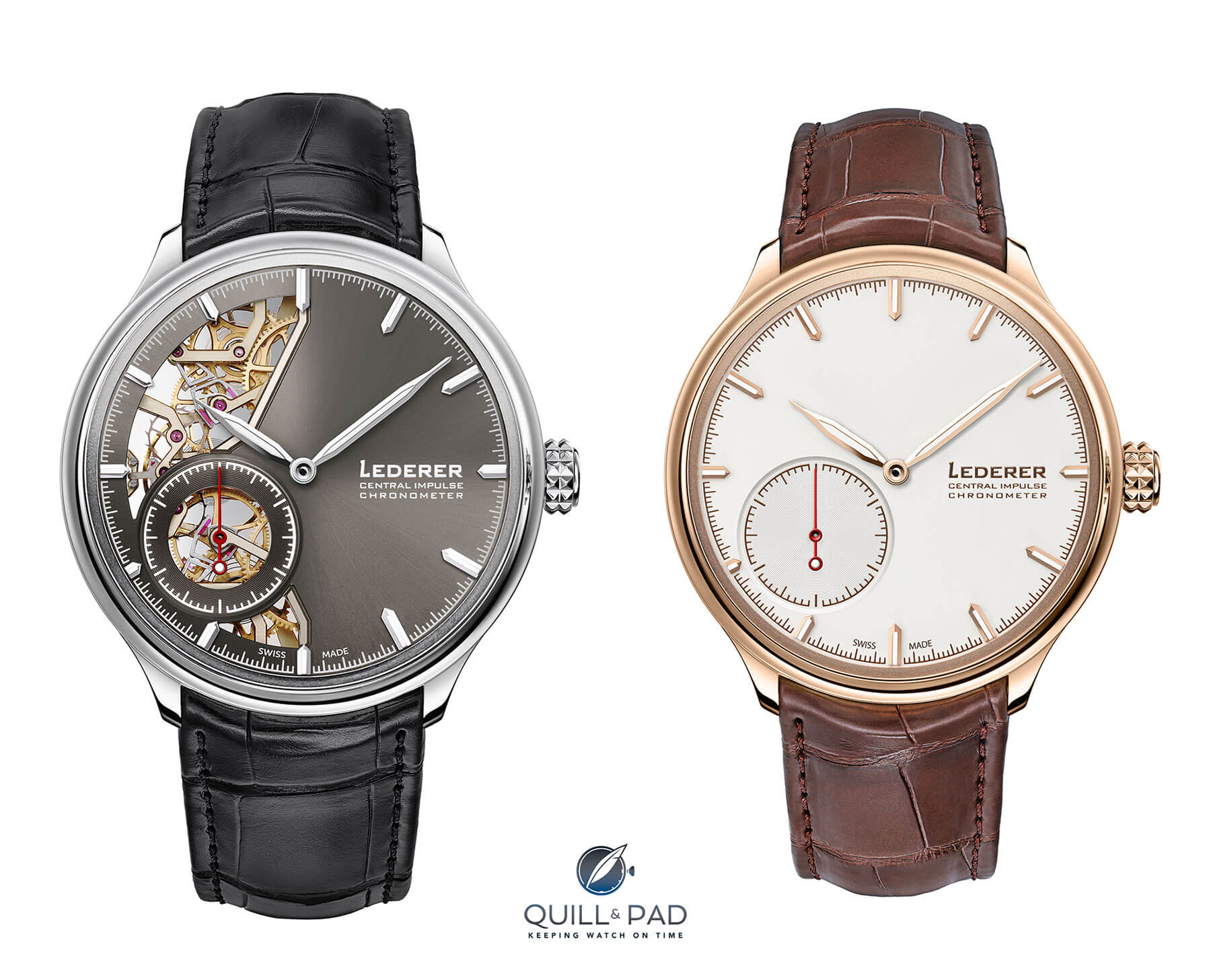
Bernhard Lederer Central Impulse Chronometer in white gold (left) and pink gold
The Central Impulse Chronometer is a rather traditional-looking timepiece with a time-only display featuring an offset seconds dial and presented in two models. The first is the most unassuming with a solid opaline dial and applied minute markers featuring a domed sapphire crystal and very restrained aesthetic.
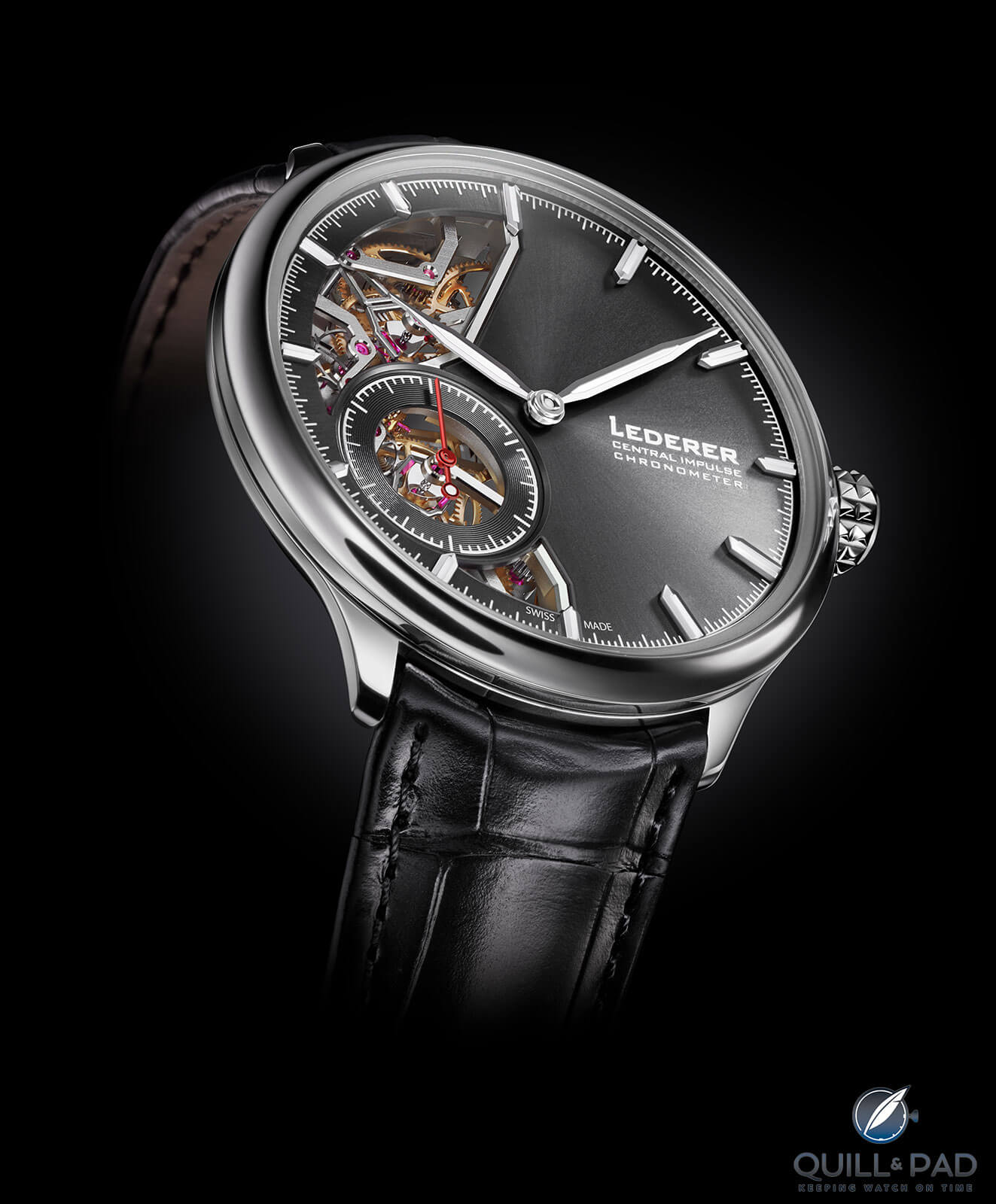
Bernhard Lederer Central Impulse Chronometer in white gold with openworked dial
The second version is where we begin to realize there is more than meets the eye. With a slate-grey sunburst dial and at least 40 percent of the dial cut away to reveal the movement underneath, we see that the Central Impulse Chronometer houses a bit of a secret. Flipping the watch over is the moment when your jaw smashes through the floor as Caliber 9012 punches you in the face with a level of fantastical perfection that quiets the noise in your mind and brings you inexorably to the now.
Caliber 9012 centers on an evolution of the natural escapement, whose purpose is to provide the most direct impulse to the balance with the least amount of friction, jarring, and harsh impulses seen in the typical Swiss lever-style escapements. The Central Impulse Chronometer boasts twin, independent gear trains linked to a single oscillator. Each gear train provides one-half of the impulses to the balance wheel every second.
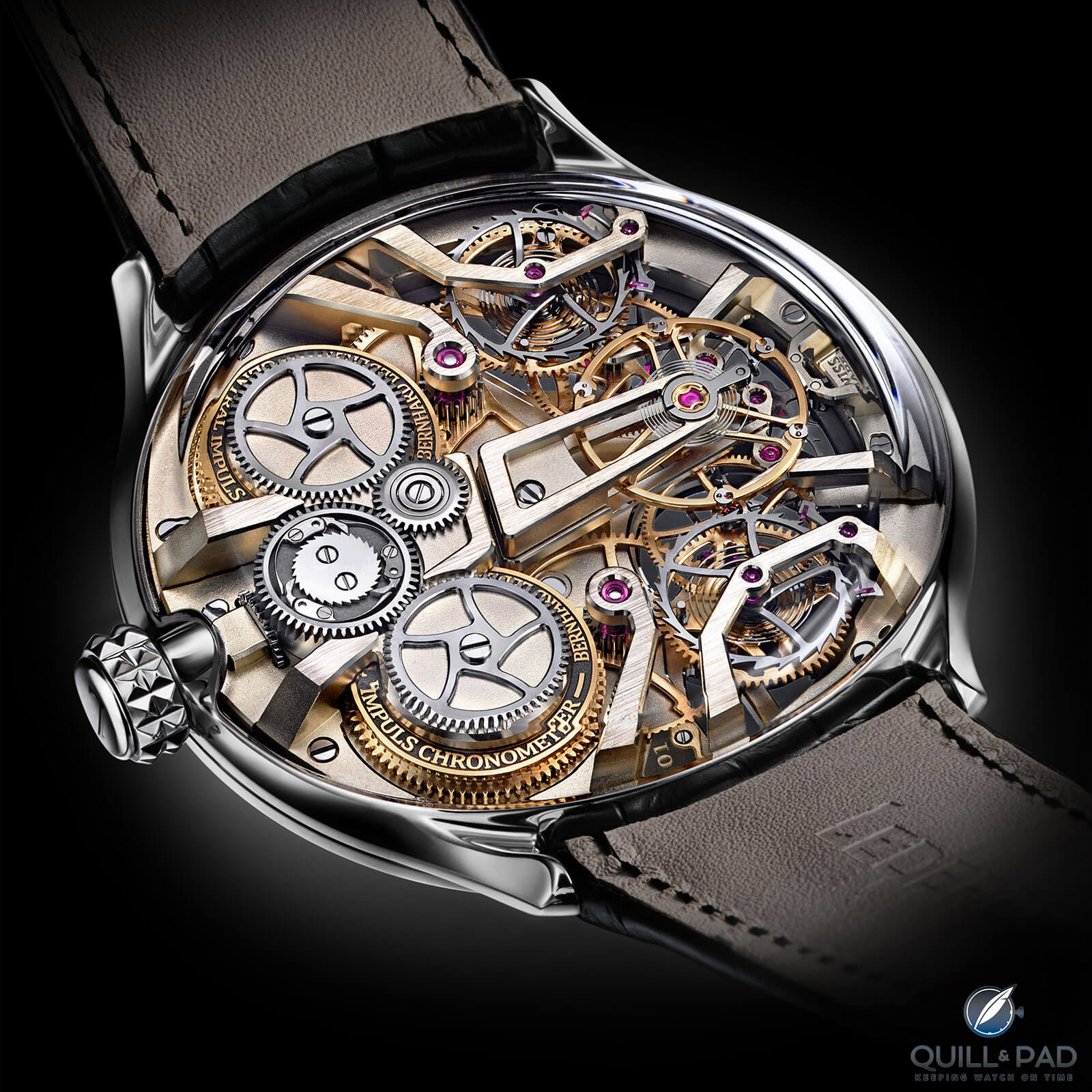
Stunning view through the display back to the movement of the Bernhard Lederer Central Impulse Chronometer
A natural escapement sits at the end of each gear train followed by a ten-second remontoir for each. This provides a more consistent force to the natural escapement for a more precise impulse, leading to improved chronometry. The twin gear trains flank the balance wheel, which lies opposite an integrated triple ratchet click winding system, allowing smooth and consistent winding of each mainspring simultaneously.
The entire caliber is visible thanks to a massively domed sapphire crystal installed with adhesive to eliminate screw bosses and provide a perfect view of the three-dimensional architecture of the movement.
Still, you may be asking why the Central Impulse Chronometer is so mechanically important and why am I so utterly frustrated by it?
Natural escapement mechanics
The reason that Lederer would work on optimizing the natural escapement for years is that it has the capacity to make a tremendously accurate movement based on some simple principles. The natural escapement takes the impulse from the escape wheels themselves and makes it more direct, square, and with as little abrupt contact as possible. The Swiss lever-style escapement allows the escape lever to basically slam into the impulse jewel on the balance wheel, almost hitting it forward instead of gently pushing it forward.
This contact is relatively abrupt and introduces shocks to the balance wheel that affect how it oscillates and the isochronism of that oscillation (the consistency of the rotation period). The natural escapement uses a different setup for the escape pallets, which change the timing and direction of the impulse and what component completes the actual impulse.
On a Swiss lever escapement, the impulse begins at an angle to the impulse jewel and pushes it through a set arc, sliding against the impulse jewel as it pushes, which introduces friction. Also, since it is a more abrupt push it may even bounce a tiny amount, which again reduces the consistency of the impulse.
With a natural escapement, the lever doesn’t hit the impulse jewel when the escape wheels release the lever and meet the balance wheel. The timing is much more precise thanks to a central pallet jewel that advances the moment of contact and allows the teeth of the escape wheel to push on the balance wheel impulse pallet jewels. The moment of contact is as close to flat and straight as possible, making the impulses light and very low friction instead of abrupt.
While these changes might seem relatively minor, when you have over half a million impulses a day there are a lot of moments where inconsistency and friction can be introduced to the mechanism. To further minimize those inconsistencies, ten-second remontoir mechanisms on each gear train seek to regulate the force that the escape wheels can impart in the first place.
Understanding that the mainspring cannot provide perfectly consistent torque throughout the entire power reserve, the remontoir mechanisms are fitted with tiny spiral springs attached to their own escape wheels. These springs are recharged every ten seconds, alternately offset from each other, which allows a much shorter period of force that can vary, and it will vary by the exact same very tiny amount with each impulse. That leaves the natural escapement further down the gear train in the position of providing much more consistent force, smoothing out mainspring inconsistencies to aid in isochronism.
So the purpose of all this development was increased precision, more consistent rate, and less variation from disturbances while increasing efficiency. After all, developing a new escapement system is a massive undertaking and requires not only dedication and expertise, but data-driven improvements that can be quantified and then implemented.
So how does the Central Impluse Chronometer stack up?
A chronometer?
At this point it must be said that I have only seen this watch in videos and photos, and the same goes for the rest of our team as I write this (thanks, 2020). The first thing that has struck me, though, and has utterly frustrated me, is that it is called a chronometer yet has zero information about its level of accuracy, consistency of rate, or any data related to the improvements of this mechanism design.
Some may not care, but this is a problem to me. If the entire point of years’ worth of work is to make a more consistent and more accurate watch, and the press release reads as if near perfection has been achieved, then I want to see some numbers. The movement is utterly brilliant, the aesthetic and finishing is top notch, and the presentation of the mechanism underneath a massive sapphire crystal dome makes this a visual masterpiece.
But in all seven pages of the press release and commentary on this watch, there is not a single mention of how just how precise it is. Sure, there is a lot of discussion of theory and about how the mechanisms impart force, and a lot of detail into how the mechanism functions differently than the original Breguet or the later Daniels escapements, but no hard data. No daily deviation numbers, no talk about regulation, no percentage of improvement over the Swiss lever escapement, not even a mention of quantified reductions in friction or increases in power reserve.
After we contacted him, Lederer confirmed that he has no hard data to share at the moment because he is waiting for more measuring equipment, but he is currently working on that and will share with us as soon as possible. [Editor’s note: it’s worth noting that a Witschi, the usual instrument for measuring the precision of a watch, works by timing the sounds of the pallets striking the escape wheel, which creates the ticking we hear, but with two gear trains and two escapements ticking at the same time it doesn’t work so laser measuring equipment is necessary for obtaining precise figures and hard data].
I know that with a remontoir there can be some reductions in power reserve for the increased consistency, but the Central Impulse Chronometer has two mainsprings and supposedly is much more efficient than a Swiss lever escapement, yet has a similar power reserve to many basic watches.
This does not make it less amazing, but it does put an asterisk next to its name and the claims it makes (or doesn’t even try to make). Like I previously stated, the first time I saw this watch I was gobsmacked: it is indeed a stunning horological creation from a very talented watchmaker. But this reminds me of the Koenigsegg One:1 and its reason for existing followed by how we have no verification that it lived up to its own purpose.
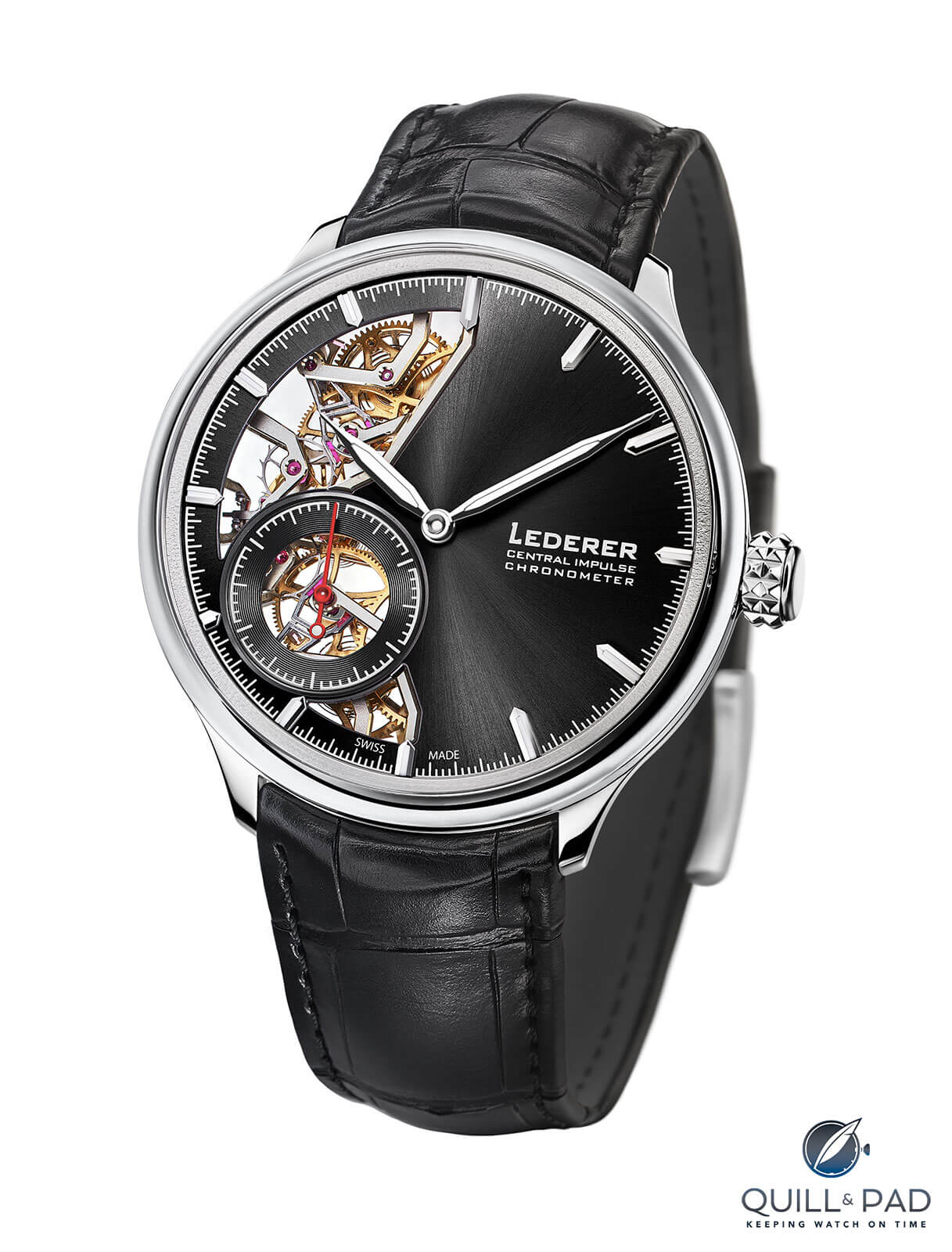
Bernhard Lederer Central Impulse Chronometer in white gold with open dial
Perhaps if it wasn’t for the way the watch world is right now with very limited access to watches, watchmakers, and time to discuss the intricacies of new movements, we might have already had a better understanding of just how great this watch is. My hope is that sooner rather than later (fingers crossed), when we can all travel to attend fairs and get more time with watches like this one, I can get answers to my questions.
And so while I hold the Koenigsegg One:1 as quite possibly the fastest production track car ever made, and the Central Impulse Chronometer as possibly one of the most accurate natural escapement wristwatches, that asterisk stands boldly due to a lack of verification for an otherwise world-class machine.
Now that I’ve been a tish harsh to something I love, let’s break it down!
- Wowza Factor * 10* To get an audible gasp from my lips the moment I saw that movement means it can’t really be topped!
- Late Night Lust Appeal * 98.9*» 969.878m/s2 The lust appeal of this watch is tremendous and it mostly comes from that incredible movement and how it is presented!
- M.G.R. * 71* It may not be a grand complication but if I ever created something that looked and worked like Caliber 9012, it would probably be my pinnacle!
- Added-Functionitis * N/A* While this watch has a lot of extra functionality in the mechanism it shares no extra information, so no need for Gotta-HAVE-That cream as well!
- Ouch Outline * 13 Stepping on a pile of Legos in the middle of the night on wooden stairs!* Combining a handful of dangerous things and the pain of stepping barefoot on Legos is pretty much the peak, yet I would happily accept the punishment if it meant getting my hands on this watch!
- Mermaid Moment * The gasp says it all!* I don’t think you can have a more immediate reaction than audibly gasping the moment you first see something. With a combination of surprise and affection it was enough to seal the deal for me.
- Awesome Total * 822.45* First take the caliber number (9012) and divide by the diameter of the case in millimeters (44), then multiply by the water resistance in atmospheres (3) before finally adding the number of movement components (208) to get an stunningly asterisked awesome total!
For more information, please visit www.bernhard-lederer.com.
Quick Facts Bernhard Lederer Central Impulse Chronometer
Case: 44 x 12.2 mm, 5N red gold or white gold
Movement: manual winding Caliber 9012 with dual gear train with dual 10 second remontoirs and natural escapements, 21,600 vph/3 Hz frequency, 38-hour power reserve
Functions: hours, minutes, seconds
Limitation: 50 pieces in each metal
Price: CHF 138,700
You may also enjoy:
John-Mikaël Flaux: Time That Moves & Magical Machines
The Watch That Changed My Life: The Jean Daniel Nicolas Two-Minute Tourbillon By Daniel Roth
Kudoke 2 Nocturne: A New Edition With Handcrafted Movement, Artistic Dial, And Sensational Value
Leave a Reply
Want to join the discussion?Feel free to contribute!



Chronometer is a protected term. To be allowed to mention it on a watch, the movemembt must pass the Chronometer certification of COSC (Contrôle officiel Suisse des Chronomètres). If the movement was testet, the test-reuslts must be somewhere.
The Swiss government latterly decided to define a chronometer in terms of the watch performance. For 150 or so years before that, the word was in common use in horology to describe an instrument with a direct-impulsing escapement (tangential impulse, usually directly by the escape wheel teeth). The B. L. is in point of fact a chronometer, whatever the regulations say. Neither was a chronometer a chronometer based purely on performance.
The historical context of chronometer means little based on its accepted use today. At over $100k I’d want a certificate. My PAM086 has Certificate noting performance at all positions and impressively performs to those standards today – 18 years later.
This is always a big issue for novelties which focus on chronometry, not only this specific watch. I totally agree some hard data should be provided by the manufacturers.
Your point is correct but if you had not mentioned the absence of figures I probably would not have noted the omission because of the complex beauty and excellence of finishing. A watch that would have to be worn reversed on the wrist to be enjoyed to the maximum.
Is this April fool’s? Do you want data on a single Central Impulse Chronometer watch or a few hundred examples of the same? Have you looked at the GPHG submissions?
Concours International de Chronométrie died, thankfully you are taking over. Let us know when VC, FP Journe and AP respond to your inquiries.
I’ve spoken with an owner of the other (and first) wristwatch with a Daniels Double Impulse escapement, the one made by Charles Frodsham. The owner found the watch to have an excellently stable rate and to be very accurate. I suppose you could ask CF if they’d be willing to share data. If they decided, as GG mentioned, to be like PP, AP, etc., I wouldn’t blame them at all.